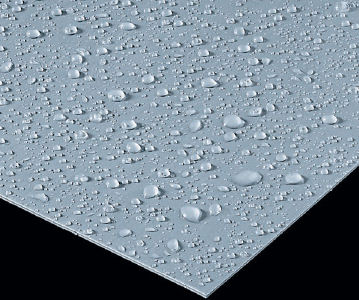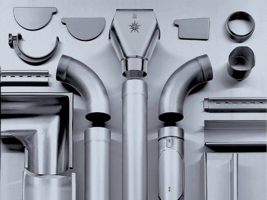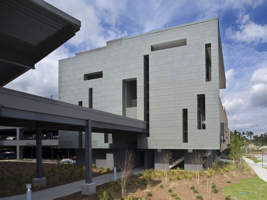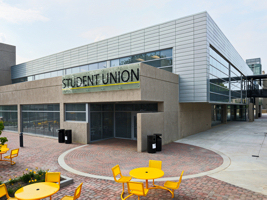Zinc Cladding: The Value And Future Of Light-Gauge GRAY
 By Steve Shull, CSI, CDT, LEED AP®
By Steve Shull, CSI, CDT, LEED AP®
Regional Sales Manager - Midwest, RHEINZINK America, Inc.
Some people, and organizations too, have a knack for seeing the future. Good business fortune is rarely pure luck. Often it’s the result of strategies that anticipate and respond to emerging market trends. Over the past decade, a commitment to working
with architectural zinc has helped some forward-thinking contractors, panel fabricators, and metal distributors grow their business. A key to success for these companies has been their ability to identify, develop & integrate new products, materials,
or applications into their services. Opportunities in sheet zinc that others may have misunderstood, opposed, or simply failed to see.
ZINC … the business of gray exteriors
Growing beyond just a specialty metal, architectural zinc (aka: titanium-zinc alloy) has become a preferred metal of many architectural designers, contractors, and building owners. Well suited for exterior applications, zinc’s “best value”
may be façade cladding where its natural gray aesthetic and durability is unmatched by coated-metal alternatives. Even in a struggling economy, the business of building “green” continues to evolve. This new paradigm shift further
stimulates the growth of those metal companies that have embraced this “old world” yet contemporary architectural metal. Zinc is nature’s gray metal and is here to stay.
The other Gray alternatives
It can be said that “imitation” is the greatest form of flattery. In the architectural “gray metal” market, it is zinc that sets the standard for NATURAL GRAY METAL. A century ago, the demand for a non-staining, malleable architectural
metal helped create lead-coated copper (LCC). Even before “lead-coat” fell out of favor amid environmental-liability issues, additional gray metal alternatives appeared as challengers:
• Zinc-Tin coated Copper
• Zinc-Tin coated Stainless Steel
• PVFD-coated Steel/Aluminum (painted metal)
 |
Environmentally friendly rainwater management is a RHEINZINK tradition. Gutter systems, rainwater collectors and accessories made of RHEINZINK titanium zinc stand out, due to innovative technology, simple assembly and installation, aesthetic
individuality and longevity. Click image to enlarge.
|  |
 | |
With the flowing shape of the conventional sine wave, Sinusoidal Profile Corrugated Panels have the appearance of filigree.The panels shown above wrap the ground level of a three-story home in Raleigh, NC. The panels were formed from RHEINZINK®
0.8mm Preweathered Graphite Gray zinc. Click image to enlarge. | |
 | |
Flat lock wall panels from RHEINZINK are the predominate cladding of the Navy Federal Credit Union in Pensacola, FL. In addition to being the largest credit union in the world, the project was the first LEED Gold commercial building in
the U.S. All told, the project utilized 134,000 sq. ft. of 0.8mm/22 gauge Graphite Gray flat lock RHEINZINK tiles. Click image to enlarge. | |
 | |
Available in diamond, rectangular and square shapes, RHEINZINK's interlocking tiles are easy to fabricate and install, and are touted as an ideal solution for curved surfaces. In the case of the project above, Beacon Park Pavilion, flat
lock tiles were used on a performance amphitheater shell. Click image to large. | |
 | |
Reveals create strong shadow lines and can be dimensioned to correspond withthe scale of masonry, stone, lap siding and other system dimensions. The application shown above is the new Student Union at Northern Kentucky University. The
project utilizes approximately 30,000 sq. ft. of RHEINZINK® 1.0mm Preweathered Blue-Gray horizontal reveal panels and 500 sq. ft. of 1.5mm RHEINZINK Preweathered Blue-Gray perforated reveal panels. Click image to enlarge. | |
 | |
Double lock and the angle lock standing seam configurations have been used since the nineteenth century for both roofing and wall claddings, providing superior weather resistance in all climates. For the project above, the Robert F. Kennedy
Community Schools Complex in Los Angeles, approximately 35,000 sq. ft. RHEINZINK 0.8mm/22 gauge Pre-weathered Blue-Gray Double Lock Standing Seam Panels were utilized. Click image to enlarge. | |
THE VIRTUES OF ZINC
Architectural zinc is a malleable sheet metal that has been used on the exterior of European buildings for almost 300 years. Zinc is a natural weathering metal that forms a beautiful warm gray patina after exposure to water and free flowing air. Valued
primarily for its natural gray aesthetic, zinc provides a long service life which varies by application type and rainwater erosion. Other benefits of zinc include: ease of fabrication, clear storm-water runoff, maintenance free, economical first cost,
high salvage value, & time-tested performance.
VALUE OF NATURAL COLOR
Zinc provides a natural gray color without the use of any synthetic color coating. The zinc carbonate patina provides the characteristic variegated warm gray color. Gray generally carries a neutral tone. As such, it’s this neutral quality that helps
gray materials complement other more dominant colors. Gray can look great alone or help other materials look their best. As the primary color theme or as a complement to other natural materials, zinc has the character that can’t be imitated
or synthetically reproduced.
VALUE OF MONOLITHIC MATERIAL
Titanium-zinc is a monolithic metal which helps it retain a low to no maintenance aesthetic. All exposed metal surfaces including scratches & cut edges will form the gray patina reducing the need for outside interference. Recycling zinc
scrap or damaged panels is much less polluting since no synthetic coatings are incinerated.
VALUE OF DURABILITY
Good design and quality materials are two requirements for durable construction. Zinc’s durability provides a long-term natural aesthetic that requires low or no maintenance. Durable materials like zinc provide a lower life-cycle cost than lower
quality alternatives. As a wall cladding material, zinc can be expected to last for centuries.
VALUE OF GREEN
Zinc has a low primary energy content (embodied energy) compared to other architectural metals. Capable of eliminating all waste (100% scrap recycling is possible), zinc promises to be the environmental leader of the architectural metals industry.
ZINC CLADDING PROFILES
Heavy-gauge zinc rainscreen panels will provide a very long service life (200+ years). For shorter service requirements (150 years), light-gauge zinc cladding may provide an economical alternative. Light-gauge rollforming equipment provides an economical
way to fabricate some interesting panel profiles. With the ability to alter the orientation (horizontal, vertical, or diagonal) of the panel seams, architects are able to achieve inspiring wall elevations with light-gauge zinc as well. Some of these
zinc profile alternatives include:
• Corrugated
Common sinusoidal profiles have heights of ½”, ¾”, & 7/8” with a typical frequency of 2.67”. Trapezoidal or box corrugated profiles for wall applications vary widely in profile but generally is deeper/ higher (1”+)
in section and provides a much stronger shadow effect. Either profile will provide the zinc sheet with greater rigidity & strength. Both signwave & trapezoidal corrugated profiles are an excellent way to maximize panel strength while minimizing
metal cost with light-gauge (0.7 mm – 0.8 mm) zinc.
• Standing Seam
Vertical standing seam pans using the single-lock or double-lock seaming method have long been used for roof applications. Using this familiar profile on the wall surface with seams oriented horizontally (or vertically for shorter panels) makes a very
cost effective zinc cladding. Given the optimum drainage plane, the single-lock (or angled-seam) installation method is preferred to allow maximum horizontal panel movement. With 1” seam height, standing seam pans are typically 12” –
16.7” wide. For zinc snap-seam profiles, consult the panel manufacturer for information regarding the acceptance of zinc specific to that seam type.
• Flush /Reveal Panels
Architects looking for a monolithic natural gray wall with minimal shadow lines often choose a flush (hairline joint) panel. Similar profiles with extended “male” lateral edges will create a reveal or recessed seam. Both profiles can be installed
in a horizontal or vertical orientation. Shorter panels can be through-fastened at the bottom female s-lock joint. Longer lengths (> 10’) should consider using a sliding clip to accommodate thermal movement. To balance oil-canning and
material cost, the face dimension (usually 8” – 12”) & material thickness (0.8 mm – 1.0 mm) should be coordinated. Opportunities to stiffen the profile can be achieved with panel-end “return” bends.
• Interlocking/ Flat-Lock Tile
Flat-lock wall tiles provide an easy to install dry-joint wall cladding solution. Interlocking tiles are a popular profile choice with many sizes, shapes, metal thicknesses, and orientation patterns. Flat-locks offer numerous design alternatives. Interlocking
tiles can be fabricated into various shapes including: rectangles, squares, & diamonds. The time required to cut, notch, & fold interlocking tiles makes them more costly to fabricate than rollformed profiles. Indirectly attached
with concealed clips, flat-lock tiles provide a low-tech profile with built-in expansion provisions at every joint. Interlocking tiles offer a zinc solution with character provided by extra texture and seaming patterns.
As those businesses experienced in architectural zinc continue to prosper, new fabricators, installers, distributors, and new metal profiles will enter the market. Zinc is a natural metal whose time has arrived. Working with designers who want to
use natural materials, light-gauge zinc will be a material that provides maximum value in a tough economy. With green building a value of the present & future, the color of architectural metal is looking very GRAY.
About RHEINZINK America Inc.
 RHEINZINK America, Inc. is a North American provider of architectural zinc used in the fabrication of roofing, facades, rainware and architectural details. For more information visit www.rheinzink.us.
RHEINZINK America, Inc. is a North American provider of architectural zinc used in the fabrication of roofing, facades, rainware and architectural details. For more information visit www.rheinzink.us.